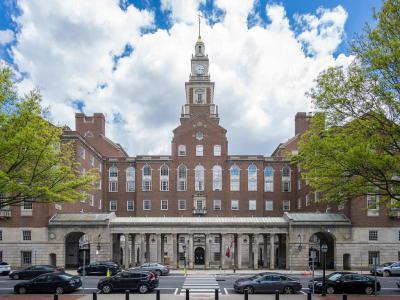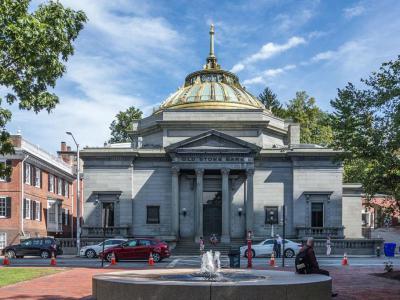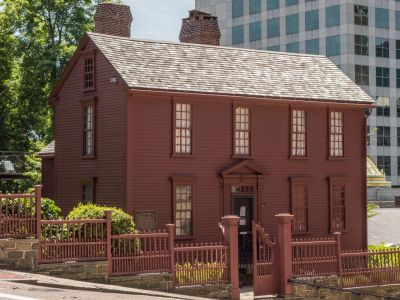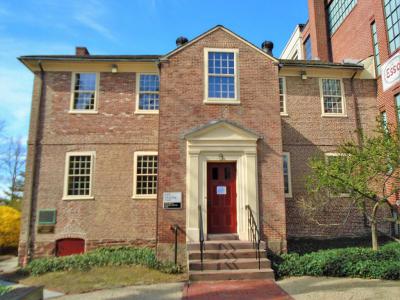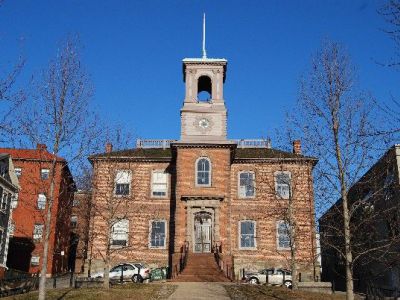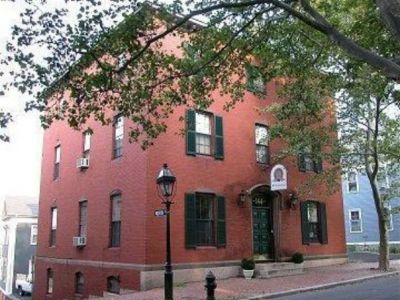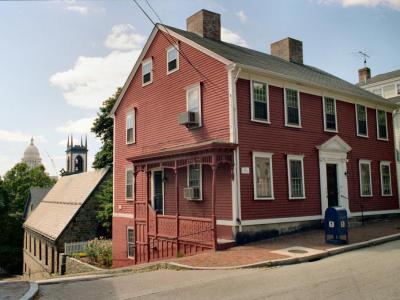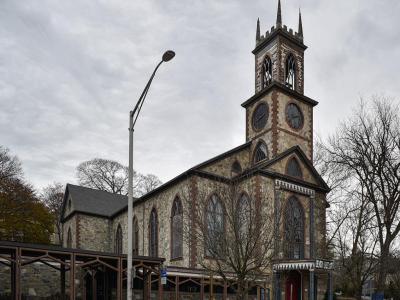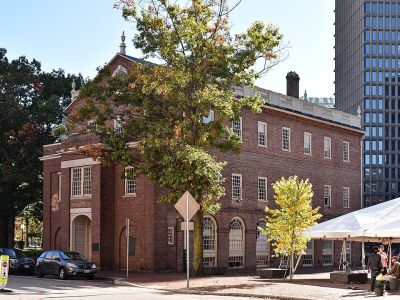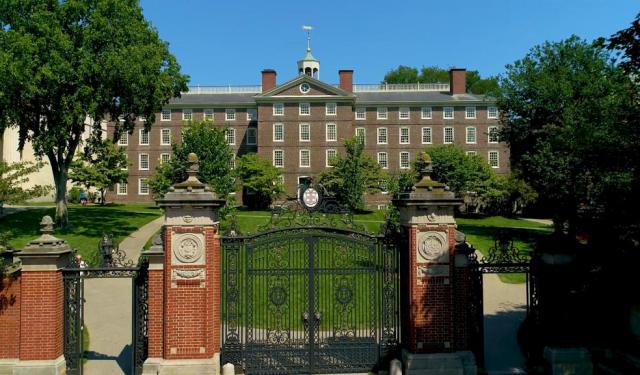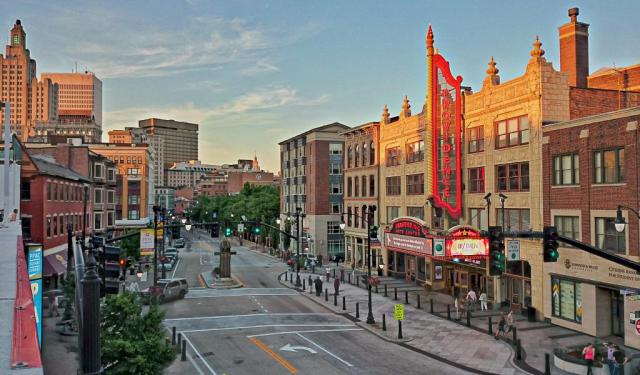
Providence Historical Buildings Tour (Self Guided), Providence
A beautiful city on the banks of the Providence River, Providence, Rhode Island, is nearly as old as the United States themselves – founded in 1636. As such, the city has many interesting historical and architectural landmarks worth checking out that tell the story of its past.
Among these, the Providence County Courthouse stands as a symbol of justice and governance. The Old Stone Bank, with its sturdy stone façade, lives up to its name and serves as a reminder of the city's financial history. The Governor Stephen Hopkins House offers a glimpse into the life of one of Rhode Island's prominent figures, while the Providence Athenaeum is a testament to the city's intellectual heritage.
The Brick School House once played a pivotal role in Providence's educational history, currently housing the headquarters for the Providence Preservation Society. The Old State House, with its elegant architecture, is a landmark of governmental authority. For those seeking a unique stay, the Old Court Bed & Breakfast offers a charming retreat within historical walls. The Sullivan Dorr House and the Sarah Helen Whitman House provide insights into the lives of notable Providence residents.
Religious heritage is also evident in the Cathedral of Saint John, a majestic structure that has been a focal point of spiritual life for generations. Fleur-de-Lis Studios showcases the city's artistic flair, while the Market House – listed on the National Register of Historic Places – remains a hub of activity as a part of the Rhode Island School of Design since 1948.
Collectively, these historical buildings represent a window into Providence's past, allowing visitors to connect with the city's profound heritage. A visit there promises a culturally enriching experience – a chance to learn about the stories embedded in these walls. So why not take this self-guided stroll and discover the charm of Providence's historical buildings for yourself?
Among these, the Providence County Courthouse stands as a symbol of justice and governance. The Old Stone Bank, with its sturdy stone façade, lives up to its name and serves as a reminder of the city's financial history. The Governor Stephen Hopkins House offers a glimpse into the life of one of Rhode Island's prominent figures, while the Providence Athenaeum is a testament to the city's intellectual heritage.
The Brick School House once played a pivotal role in Providence's educational history, currently housing the headquarters for the Providence Preservation Society. The Old State House, with its elegant architecture, is a landmark of governmental authority. For those seeking a unique stay, the Old Court Bed & Breakfast offers a charming retreat within historical walls. The Sullivan Dorr House and the Sarah Helen Whitman House provide insights into the lives of notable Providence residents.
Religious heritage is also evident in the Cathedral of Saint John, a majestic structure that has been a focal point of spiritual life for generations. Fleur-de-Lis Studios showcases the city's artistic flair, while the Market House – listed on the National Register of Historic Places – remains a hub of activity as a part of the Rhode Island School of Design since 1948.
Collectively, these historical buildings represent a window into Providence's past, allowing visitors to connect with the city's profound heritage. A visit there promises a culturally enriching experience – a chance to learn about the stories embedded in these walls. So why not take this self-guided stroll and discover the charm of Providence's historical buildings for yourself?
How it works: Download the app "GPSmyCity: Walks in 1K+ Cities" from Apple App Store or Google Play Store to your mobile phone or tablet. The app turns your mobile device into a personal tour guide and its built-in GPS navigation functions guide you from one tour stop to next. The app works offline, so no data plan is needed when traveling abroad.
Providence Historical Buildings Tour Map
Guide Name: Providence Historical Buildings Tour
Guide Location: USA » Providence (See other walking tours in Providence)
Guide Type: Self-guided Walking Tour (Sightseeing)
# of Attractions: 12
Tour Duration: 2 Hour(s)
Travel Distance: 2.0 Km or 1.2 Miles
Author: alice
Sight(s) Featured in This Guide:
Guide Location: USA » Providence (See other walking tours in Providence)
Guide Type: Self-guided Walking Tour (Sightseeing)
# of Attractions: 12
Tour Duration: 2 Hour(s)
Travel Distance: 2.0 Km or 1.2 Miles
Author: alice
Sight(s) Featured in This Guide:
- Providence County Courthouse
- Old Stone Bank
- Governor Stephen Hopkins House
- Providence Athenaeum
- Brick Schoolhouse
- Old State House
- Old Court
- Sullivan Dorr House
- Sarah Helen Whitman House
- Cathedral of St. John
- Fleur-de-Lys Studios
- Market House
1) Providence County Courthouse
Located in the historic College Hill neighborhood, the Providence County Courthouse is an impressive example of Georgian Revival architecture. Designed by the firm of Jackson, Robertson & Adams and completed in 1933, it features a striking red brick exterior accented with granite and limestone details, while the interior showcases Federal-style elements.
At 216 feet (66 meters) tall, the courthouse ranks as the city’s 11th tallest building. It serves as the home of the Rhode Island Supreme Court and the Providence County Superior Court, solidifying its role as a central hub for the state’s judicial system.
The site’s governmental roots stretch back to the 18th century. The original Town House, built in 1723, provided a space for public meetings and court sessions. In 1875, a Victorian High Gothic courthouse replaced the Town House. However, as the city grew, the need for a more modern and functional facility led to the construction of the current courthouse in the early 20th century.
Architectural historian McKenzie Woodward has praised the building’s thoughtful design, noting how its large mass is broken down into smaller, visually pleasing segments that harmonize with its surroundings.
At 216 feet (66 meters) tall, the courthouse ranks as the city’s 11th tallest building. It serves as the home of the Rhode Island Supreme Court and the Providence County Superior Court, solidifying its role as a central hub for the state’s judicial system.
The site’s governmental roots stretch back to the 18th century. The original Town House, built in 1723, provided a space for public meetings and court sessions. In 1875, a Victorian High Gothic courthouse replaced the Town House. However, as the city grew, the need for a more modern and functional facility led to the construction of the current courthouse in the early 20th century.
Architectural historian McKenzie Woodward has praised the building’s thoughtful design, noting how its large mass is broken down into smaller, visually pleasing segments that harmonize with its surroundings.
2) Old Stone Bank
The Old Stone Bank, formally known as the Providence Institution for Savings, was founded in 1819 as a mutual savings bank. Unlike traditional banks, it had no stockholders or capital stock and was managed by a volunteer Board of Trustees. It initially shared space with the Providence Bank, maintaining a close connection while remaining a separate entity.
In 1854, the bank erected its signature domed building on South Main Street. This grand granite structure, topped by a green copper dome with gold-leaf accents, quickly became a recognizable Providence landmark.
By the early 1970s, the bank embraced a playful side by introducing Fred Flintstone as its mascot. In television commercials, Fred enthusiastically declared, “Yabba-dabba-doo, love that Old Stone Bank!” Even its ATMs got in on the fun, nicknamed “Ready Freddy.”
However, the bank’s fortunes turned in the 1980s after it took over two failing savings and loan institutions at the federal government’s request. The financial strain proved overwhelming, and in 1993, the Office of Thrift Supervision declared the bank insolvent. The following year, it was acquired by Citizens Bank.
Since the bank’s closure, its original South Main Street building has undergone several transformations. In 2014, there was even a proposal to transform the historic structure into a single-family residence, highlighting its suitability for adaptive reuse.
In 1854, the bank erected its signature domed building on South Main Street. This grand granite structure, topped by a green copper dome with gold-leaf accents, quickly became a recognizable Providence landmark.
By the early 1970s, the bank embraced a playful side by introducing Fred Flintstone as its mascot. In television commercials, Fred enthusiastically declared, “Yabba-dabba-doo, love that Old Stone Bank!” Even its ATMs got in on the fun, nicknamed “Ready Freddy.”
However, the bank’s fortunes turned in the 1980s after it took over two failing savings and loan institutions at the federal government’s request. The financial strain proved overwhelming, and in 1993, the Office of Thrift Supervision declared the bank insolvent. The following year, it was acquired by Citizens Bank.
Since the bank’s closure, its original South Main Street building has undergone several transformations. In 2014, there was even a proposal to transform the historic structure into a single-family residence, highlighting its suitability for adaptive reuse.
3) Governor Stephen Hopkins House (must see)
Step into Providence’s oldest surviving home, a living monument to early American history. Known as the Stephen Hopkins House, this residence honors its remarkable namesake. Hopkins wasn’t just any colonist: he signed the Declaration of Independence, served as Rhode Island’s Governor not once but ten times, and even held roles as Chief Justice and a delegate to both the Colonial and Continental Congresses.
In 1743, Hopkins bought and expanded this home, residing here until his death in 1785. He played a key role in shaping Providence’s civic and economic foundation. By the time he added his signature to the Declaration of Independence, he was nearly 70 and battling what is thought to have been Parkinson’s Disease. Despite his trembling hand, he famously declared, “My hand trembles, my heart does not.”
One of the house’s most memorable moments came on April 5, 1776, when George Washington himself stayed overnight. Hopkins himself was away, so his daughter-in-law hosted the General. Local lore has it she refused to borrow fine china for the occasion, saying what was good enough for her father-in-law was good enough for Washington.
Today, visitors can stand in the room where Washington slept and learn about Hopkins’ extraordinary life. The home, recognized as both a National Register site and a National Historic Landmark, preserves the legacy of a man who dedicated himself to both Rhode Island and the founding of a new nation.
In 1743, Hopkins bought and expanded this home, residing here until his death in 1785. He played a key role in shaping Providence’s civic and economic foundation. By the time he added his signature to the Declaration of Independence, he was nearly 70 and battling what is thought to have been Parkinson’s Disease. Despite his trembling hand, he famously declared, “My hand trembles, my heart does not.”
One of the house’s most memorable moments came on April 5, 1776, when George Washington himself stayed overnight. Hopkins himself was away, so his daughter-in-law hosted the General. Local lore has it she refused to borrow fine china for the occasion, saying what was good enough for her father-in-law was good enough for Washington.
Today, visitors can stand in the room where Washington slept and learn about Hopkins’ extraordinary life. The home, recognized as both a National Register site and a National Historic Landmark, preserves the legacy of a man who dedicated himself to both Rhode Island and the founding of a new nation.
4) Providence Athenaeum
The Providence Athenæum was formed by merging two early subscription libraries: the Providence Library Company, founded in 1753, and a previous incarnation of the Providence Athenæum, established in 1831. This union gave rise to the institution we know today, which first opened its Greek Revival building on July 11, 1838. Designed by Philadelphia architect William Strickland, the structure features a temple-like façade with a prominent main entry elevated a full story above ground. Built from Rhode Island granite, the structure includes a recessed portico with a double wood door, embodying the refined style of the 19th century.
Over the years, the Athenæum has hosted many renowned figures, including Edgar Allan Poe, who visited in 1848 while courting Providence poet Sarah Helen Whitman. Their well-documented meetings within the library’s walls lend a touch of literary intrigue to the institution’s history.
The library’s collection spans centuries, reflecting the evolving interests of its members. Its Special Collections include rare books and manuscripts with notable strengths in literature, history, travel, fine arts, and natural sciences. The Founders’ Collection, which survived a catastrophic fire in 1758, offers a direct connection to the library’s earliest days.
Open to the public, the Athenæum invites visitors to explore its rich history and collections through self-guided tours. While the main and lower levels are open to all, exclusive spaces such as the mezzanine-level Art Room remain reserved for members.
Over the years, the Athenæum has hosted many renowned figures, including Edgar Allan Poe, who visited in 1848 while courting Providence poet Sarah Helen Whitman. Their well-documented meetings within the library’s walls lend a touch of literary intrigue to the institution’s history.
The library’s collection spans centuries, reflecting the evolving interests of its members. Its Special Collections include rare books and manuscripts with notable strengths in literature, history, travel, fine arts, and natural sciences. The Founders’ Collection, which survived a catastrophic fire in 1758, offers a direct connection to the library’s earliest days.
Open to the public, the Athenæum invites visitors to explore its rich history and collections through self-guided tours. While the main and lower levels are open to all, exclusive spaces such as the mezzanine-level Art Room remain reserved for members.
5) Brick Schoolhouse
Tucked modestly away from the street, this is one of the nation’s oldest public school buildings. Providence’s initial attempts at public education were ambitious but met with early challenges. Originally, the first floor housed a mixed-age elementary school, while the second floor served students of what is now Brown University until the College Edifice was completed. After 1800, it returned to continuous use as an elementary school and remained a cornerstone of public education.
In the mid-19th century, the school became a designated institution for African American students. Then, in 1908, it was repurposed into an “open air” school for children with tuberculosis, a bold adaptation that saw large sections of the second-story walls removed to improve ventilation. By the mid-20th century, the building had evolved into a school serving children of all mental and physical abilities. This pioneering effort, which became known as the Meeting Street School, established a legacy of innovative education.
Currently owned by the City of Providence, the building was listed on the National Register of Historic Places in 1972 and now serves as the headquarters of the Providence Preservation Society (PPS). Founded in 1956 to save the East Side’s historic 18th and 19th-century structures from demolition, the PPS not only restored this landmark building but also preserved the character of entire neighborhoods. Today, the PPS is a citywide advocate for preservation, continuing to protect Providence’s architectural heritage.
In the mid-19th century, the school became a designated institution for African American students. Then, in 1908, it was repurposed into an “open air” school for children with tuberculosis, a bold adaptation that saw large sections of the second-story walls removed to improve ventilation. By the mid-20th century, the building had evolved into a school serving children of all mental and physical abilities. This pioneering effort, which became known as the Meeting Street School, established a legacy of innovative education.
Currently owned by the City of Providence, the building was listed on the National Register of Historic Places in 1972 and now serves as the headquarters of the Providence Preservation Society (PPS). Founded in 1956 to save the East Side’s historic 18th and 19th-century structures from demolition, the PPS not only restored this landmark building but also preserved the character of entire neighborhoods. Today, the PPS is a citywide advocate for preservation, continuing to protect Providence’s architectural heritage.
6) Old State House
The Old State House, an architectural centerpiece in Providence’s College Hill Historic District, has been at the heart of Rhode Island’s political life since the colonial era. It is one of only six surviving state houses from the colonial period in the United States, with three of those located in Rhode Island. Over time, this landmark has come to symbolize both the city’s growing political influence and the evolving nature of the state’s governance.
The building has witnessed some of the state’s most transformative moments. On May 4, 1776, Rhode Island’s General Assembly met here and declared independence from Britain, making it the first colony to renounce allegiance to the Crown. In 1783, the Assembly abolished voting restrictions for Roman Catholics, and a year later, it passed the Gradual Emancipation Act—one of the earliest steps toward ending slavery in the United States. In 1852, Rhode Island’s legislature became one of the first to eliminate the death penalty, all under the roof of the Old State House.
Constructed between 1760 and 1762, with expansions added in the 19th century, the building exemplifies Georgian architecture. Its brick and brownstone design embodies the colonial era’s aesthetics and its enduring heritage. Today, the Old State House stands as a National Register of Historic Places landmark of national significance in both politics and architecture. Since 1975, it has been maintained by the Rhode Island Historical Preservation Commission, which carried out a restoration effort in 2020 to ensure its continued prominence.
The building has witnessed some of the state’s most transformative moments. On May 4, 1776, Rhode Island’s General Assembly met here and declared independence from Britain, making it the first colony to renounce allegiance to the Crown. In 1783, the Assembly abolished voting restrictions for Roman Catholics, and a year later, it passed the Gradual Emancipation Act—one of the earliest steps toward ending slavery in the United States. In 1852, Rhode Island’s legislature became one of the first to eliminate the death penalty, all under the roof of the Old State House.
Constructed between 1760 and 1762, with expansions added in the 19th century, the building exemplifies Georgian architecture. Its brick and brownstone design embodies the colonial era’s aesthetics and its enduring heritage. Today, the Old State House stands as a National Register of Historic Places landmark of national significance in both politics and architecture. Since 1975, it has been maintained by the Rhode Island Historical Preservation Commission, which carried out a restoration effort in 2020 to ensure its continued prominence.
7) Old Court
The Old Court is another historic treasure in Providence’s College Hill neighborhood. Built in 1863 by Alpheus Morse, this Victorian-Italianate building originally served as a rectory. Its design features classic Italianate details, including intricate mantles, ornate plaster crown moldings, and soaring twelve-foot ceilings, all of which showcase the refined style of the era.
Over the years, the building has experienced various transformations. In the mid-20th century, it was converted into a bed and breakfast that combined historic charm with modern conveniences. Its ten uniquely decorated rooms maintained a 19th-century aesthetic while offering contemporary amenities. The property’s location near Brown University and the Rhode Island School of Design made it a favorite choice for visiting parents and academics.
Recently, however, the building’s story has taken a new turn. In March 2022, the Old Court ceased operating as a bed and breakfast. Developers have proposed converting the historic property into luxury apartments, with plans to maintain its architectural character while updating it for residential living. This transition has faced some opposition from preservationists and community members who value the building's historical significance.
Over the years, the building has experienced various transformations. In the mid-20th century, it was converted into a bed and breakfast that combined historic charm with modern conveniences. Its ten uniquely decorated rooms maintained a 19th-century aesthetic while offering contemporary amenities. The property’s location near Brown University and the Rhode Island School of Design made it a favorite choice for visiting parents and academics.
Recently, however, the building’s story has taken a new turn. In March 2022, the Old Court ceased operating as a bed and breakfast. Developers have proposed converting the historic property into luxury apartments, with plans to maintain its architectural character while updating it for residential living. This transition has faced some opposition from preservationists and community members who value the building's historical significance.
8) Sullivan Dorr House
Calling this merely ambitious doesn’t do it justice. The house before you is a bold statement, designed and constructed by John Holden Greene—Providence’s go-to architectural talent of the late Federal period. Greene, then just 32 and hitting his creative stride, built this for a Boston-born merchant active in the China Trade who had married into the wealthy Allen family. It was a commission that clearly satisfied his well-heeled patrons; several other Allen relatives would turn to Greene for their own homes.
Though Providence had started seeing large three-story houses about four decades earlier, none matched the scale and complexity of this one. Here, Greene conceived an integrated compound: the main house, a service ell set back from the front, and connected quarters for servants and a barn, all constructed simultaneously. This created what might be Providence’s earliest example of such an expansive layout. Greene’s adept siting—aligning the house perpendicular to the street and terracing up the hill—was a marked departure from earlier, more straightforward designs on the steep eastern side of the street. It was also significantly more expensive and land-intensive, showcasing a level of sophistication that set a new standard for local architecture.
Greene’s background as a builder’s apprentice, combined with his use of architectural pattern books, is evident in the house’s details. Gothic-inspired trim below the roofline and on the front porch, along with the stepped massing of the main block, are all hallmarks of his approach. This stepped design, while visually striking, doesn’t radically reconfigure the interior spaces as one might expect. Still, the house’s design remains a grand gesture, establishing an architectural identity for Providence.
Though Providence had started seeing large three-story houses about four decades earlier, none matched the scale and complexity of this one. Here, Greene conceived an integrated compound: the main house, a service ell set back from the front, and connected quarters for servants and a barn, all constructed simultaneously. This created what might be Providence’s earliest example of such an expansive layout. Greene’s adept siting—aligning the house perpendicular to the street and terracing up the hill—was a marked departure from earlier, more straightforward designs on the steep eastern side of the street. It was also significantly more expensive and land-intensive, showcasing a level of sophistication that set a new standard for local architecture.
Greene’s background as a builder’s apprentice, combined with his use of architectural pattern books, is evident in the house’s details. Gothic-inspired trim below the roofline and on the front porch, along with the stepped massing of the main block, are all hallmarks of his approach. This stepped design, while visually striking, doesn’t radically reconfigure the interior spaces as one might expect. Still, the house’s design remains a grand gesture, establishing an architectural identity for Providence.
9) Sarah Helen Whitman House
Situated at 88 Benefit Street, this Colonial-style home holds a special place in history as the residence connected to esteemed poet and essayist Sarah Helen Whitman. Built between 1783 and 1793, the southern half of the two-family dwelling was rented by Whitman’s mother, Anna Power, in 1816. It features a central hall, two interior chimneys, and five rooms, characteristic of Colonial architecture. Its distinctive red exterior, which Whitman reportedly disliked, contrasts sharply with the intricate woodwork inside, a feature she greatly admired.
Sarah Helen Whitman, born in 1803, was a prominent figure in Providence’s literary and intellectual circles. Her work, infused with themes of transcendentalism, spiritualism, and feminism, solidified her reputation as a leading thinker of her time. Whitman is most famously remembered for her brief engagement to Edgar Allan Poe in 1848. Their courtship unfolded at this Benefit Street home, where Poe was said to be captivated by her intellect and charm. It’s widely believed that Poe penned the poem “To Helen” in her honor, inspired by seeing her tending her rose garden under a moonlit sky.
From its perch, the house offers lovely views of Saint John’s Cathedral and its historic cemetery. Though privately owned, it continues to attract literary enthusiasts and historians who appreciate its deep ties to Providence’s cultural and literary heritage.
Sarah Helen Whitman, born in 1803, was a prominent figure in Providence’s literary and intellectual circles. Her work, infused with themes of transcendentalism, spiritualism, and feminism, solidified her reputation as a leading thinker of her time. Whitman is most famously remembered for her brief engagement to Edgar Allan Poe in 1848. Their courtship unfolded at this Benefit Street home, where Poe was said to be captivated by her intellect and charm. It’s widely believed that Poe penned the poem “To Helen” in her honor, inspired by seeing her tending her rose garden under a moonlit sky.
From its perch, the house offers lovely views of Saint John’s Cathedral and its historic cemetery. Though privately owned, it continues to attract literary enthusiasts and historians who appreciate its deep ties to Providence’s cultural and literary heritage.
10) Cathedral of St. John
Founded in 1722 as King's Church, the Cathedral of Saint John was the first Episcopal congregation in Providence. The original wooden building served the parish until the early 19th century, when architect John Holden Greene designed a new stone structure in the early Gothic Revival style. Completed in 1810, Greene’s design featured a nave flanked by an entrance stair tower, drawing heavily on English architectural pattern books of the period.
Over the years, the structure saw numerous changes that reflected shifting architectural styles and liturgical needs. Richard Upjohn added a chapel in 1856, followed by Clifton A. Hall’s south transept in 1866. The interior was later remodeled in a Baroque style in 1905, and additional updates were made in 1967. In 1929, the church was named the official seat of the Episcopal Diocese of Rhode Island, becoming the Cathedral of Saint John.
However, declining membership and significant renovation needs forced the cathedral to close in 2012. Two years later, the Episcopal Diocese announced plans to convert the space into a museum and reconciliation center exploring Rhode Island’s role in the trans-Atlantic slave trade. The project aims to acknowledge both the beneficiaries and the opponents of slavery, making it the first U.S. museum focused on slavery’s history in New England.
Over the years, the structure saw numerous changes that reflected shifting architectural styles and liturgical needs. Richard Upjohn added a chapel in 1856, followed by Clifton A. Hall’s south transept in 1866. The interior was later remodeled in a Baroque style in 1905, and additional updates were made in 1967. In 1929, the church was named the official seat of the Episcopal Diocese of Rhode Island, becoming the Cathedral of Saint John.
However, declining membership and significant renovation needs forced the cathedral to close in 2012. Two years later, the Episcopal Diocese announced plans to convert the space into a museum and reconciliation center exploring Rhode Island’s role in the trans-Atlantic slave trade. The project aims to acknowledge both the beneficiaries and the opponents of slavery, making it the first U.S. museum focused on slavery’s history in New England.
11) Fleur-de-Lys Studios
As industrialization spread along the Blackstone River in Providence and beyond, a group of artists rejected mass production in favor of handcrafted work. This movement, known as the Arts and Crafts Movement, inspired painter Sydney Burleigh and architect Edmund R. Willson to create a space that celebrated craftsmanship and artistry. Drawing inspiration from the half-timbered buildings of Chester, England, they designed the Fleur-de-Lys Studios. Its façade is adorned with intricate stucco panels featuring low-relief sculptures that symbolize Sculpture, Painting, and Architecture, reinforcing the unity of the visual arts.
Upon completion, the Fleur-de-Lys quickly gained recognition in architectural circles for its inventive design and its adherence to Arts and Crafts ideals. The building became a haven for prominent artists, including Burleigh himself and George William Whitaker, celebrated as the “Dean of Providence Painters.” In 1939, following Burleigh’s passing, his widow gifted the building to the Providence Art Club, with the stipulation that it continue as a creative studio space—an arrangement that endures to this day.
The Fleur-de-Lys Studios also found its way into popular culture. H.P. Lovecraft used it as the home of Henry Wilcox, a character in “The Call of Cthulhu,” famously describing it as “a hideous Victorian imitation of seventeenth-century Breton architecture.”
Recognizing its architectural and cultural importance, the Fleur-de-Lys Studios was designated a National Historic Landmark in 1992.
Upon completion, the Fleur-de-Lys quickly gained recognition in architectural circles for its inventive design and its adherence to Arts and Crafts ideals. The building became a haven for prominent artists, including Burleigh himself and George William Whitaker, celebrated as the “Dean of Providence Painters.” In 1939, following Burleigh’s passing, his widow gifted the building to the Providence Art Club, with the stipulation that it continue as a creative studio space—an arrangement that endures to this day.
The Fleur-de-Lys Studios also found its way into popular culture. H.P. Lovecraft used it as the home of Henry Wilcox, a character in “The Call of Cthulhu,” famously describing it as “a hideous Victorian imitation of seventeenth-century Breton architecture.”
Recognizing its architectural and cultural importance, the Fleur-de-Lys Studios was designated a National Historic Landmark in 1992.
12) Market House
Nestled in the heart of College Hill, the Market House is Providence’s brick-built blast from the past. Constructed in the 1770s and exemplifying Georgian architecture, this historic structure was originally designed to juggle commerce and civic affairs. Back then, the ground floor bustled with market vendors, while the upper floor hosted public gatherings—and probably some heated debates.
At first, the Market House was a modest two-story affair with by a low gable roof. But in 1797, it got an upgrade: a third floor was added to accommodate Rhode Island’s first Masonic Lodge. A wooden balustrade was thrown in for good measure, along with a large bull’s-eye window on the east gable and a clock on the west—though that wasn’t added until the 20th century. In true architectural fashion, the first floor’s original arcade eventually gave way to more practical windows during the 19th century.
This building wasn’t just about looking pretty. In March of 1775, a group of local patriots gathered here to protest British taxes in the most dramatic way possible: burning British tea. Later, during the American Revolution, it even served as a barracks for French soldiers stationed in the city. And if that weren’t enough civic service, the Market House pulled double duty as Providence’s City Hall from 1832 to 1878 while everyone argued over where to put a new one.
Fast forward to 1948, and the Rhode Island School of Design took ownership, with one caveat: the exterior had to be preserved. Today, the Market House is still standing strong, with plaques marking the high-water marks of hurricanes long past, reminding us that this sturdy old structure has weathered more than a few tempests.
At first, the Market House was a modest two-story affair with by a low gable roof. But in 1797, it got an upgrade: a third floor was added to accommodate Rhode Island’s first Masonic Lodge. A wooden balustrade was thrown in for good measure, along with a large bull’s-eye window on the east gable and a clock on the west—though that wasn’t added until the 20th century. In true architectural fashion, the first floor’s original arcade eventually gave way to more practical windows during the 19th century.
This building wasn’t just about looking pretty. In March of 1775, a group of local patriots gathered here to protest British taxes in the most dramatic way possible: burning British tea. Later, during the American Revolution, it even served as a barracks for French soldiers stationed in the city. And if that weren’t enough civic service, the Market House pulled double duty as Providence’s City Hall from 1832 to 1878 while everyone argued over where to put a new one.
Fast forward to 1948, and the Rhode Island School of Design took ownership, with one caveat: the exterior had to be preserved. Today, the Market House is still standing strong, with plaques marking the high-water marks of hurricanes long past, reminding us that this sturdy old structure has weathered more than a few tempests.
Walking Tours in Providence, Rhode Island
Create Your Own Walk in Providence
Creating your own self-guided walk in Providence is easy and fun. Choose the city attractions that you want to see and a walk route map will be created just for you. You can even set your hotel as the start point of the walk.
Brown University Walking Tour
Chief among the iconic landmarks contributing to the cultural atmosphere of Providence, Rhode Island, is Brown University, a prestigious Ivy League institution known for its liberal arts education and vibrant campus life. Founded in 1764, this is the seventh-oldest university in the United States, chartered before the American Revolution.
Brown's historic campus offers a classic New... view more
Tour Duration: 2 Hour(s)
Travel Distance: 2.3 Km or 1.4 Miles
Brown's historic campus offers a classic New... view more
Tour Duration: 2 Hour(s)
Travel Distance: 2.3 Km or 1.4 Miles
Providence Introduction Walking Tour
Along the banks of the Providence River sits one of New England’s oldest and most storied settlements. Founded in 1636 by Roger Williams, a bold dissenter fleeing Massachusetts Bay Colony, it initially began as a sanctuary of religious freedom. Williams believed this haven was revealed through divine mercy—hence the name “Providence.” Over time, the city grew from its humble beginnings... view more
Tour Duration: 2 Hour(s)
Travel Distance: 3.9 Km or 2.4 Miles
Tour Duration: 2 Hour(s)
Travel Distance: 3.9 Km or 2.4 Miles
The Most Popular Cities
/ view all
